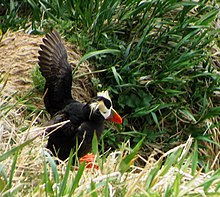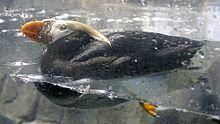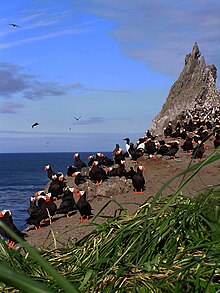en
names in breadcrumbs


Tufted Puffins have three major predators: Snowy Owls, Bald Eagles, and Arctic Foxes. Puffins try to select habitats that will be difficult for foxes to reach, and laying their eggs in burrows makes them inaccessible to the predator. However, foxes seem to prefer the puffin over other birds, making the bird a main target. (Gaston, 1998, Jewett 1953)
Tufted puffins have a limited range of calls, including a low grumbling noise heard usually from underground in breeding colonies. Chicks often peep to indicate that they want food. They use postures and other physical cues to communicate as well.
They use unknown cues for finding their way back from the vastness of the open ocean to the nesting colonies in which they were born.
Communication Channels: visual ; acoustic
Perception Channels: visual ; tactile ; acoustic ; chemical
Fratercula cirrhata is not a threatened species, but in some locations its numbers are decreasing. In Alaska, they are highly abundant, but the seabird colonies of Alaska are protected by federal and state laws. Also, a permit is often required to land on islands where puffins are nesting. In the puffin colonies along the coasts of California, Oregon, and Washington, population size has been declining since the beginning of the century due to decreasing numbers of fish, ocean pollution, and oil spills. As with most species, puffins have fallen victim to the expansion of humans. To attempt to make up for human takeover of land that was once used for puffin nesting, some programs have been set up to restore of former nesting colonies and help reduce the risk to populations by establishing more nesting sites. (Paul 1994, Small 1994)
US Migratory Bird Act: protected
US Federal List: no special status
CITES: no special status
IUCN Red List of Threatened Species: least concern
Fratercula cirrhata does no harm to humans. Puffins will only harm people when they intrude on their nesting sites. They have a beak strong enough to bite through a human finger to the bone. (Lockley 1953)
Tufted puffins were historically hunted for food. Hunting puffins is discouraged nowadays in most places, and forbidden by law in others, but people who do still hunt them try to capture only non-breeding animals. In the past, skins were used to make tough parkas worn feather side in. Puffins are also used as tourist attractions for communities near healthy colonies, but visitors must watch the birds from the ocean. Because human disturbances may cause puffins to leave their nesting sites, people are often prohibited from landing at nesting sites. Puffins are also indicators of a healthy ocean, and show humans when over-fishing is occuring. When there are fewer fish in the ocean, puffins bring a noticeably reduced amount of fish ashore. (Paul 1994, Kessel 1989)
Positive Impacts: food ; body parts are source of valuable material; ecotourism
Puffins are important predators of small fish and marine invertebrates in the areas in which they live.
Tufted puffins are primarily offshore feeders. During nesting, and when food is in abundance, they may feed inshore. The diet of chicks is almost entirely small fish, while the adults' diets are more diverse. Adults prey mostly on anchovies and other small fish, but also eat squid, octopus, crabs, zooplankton, and jellyfish.
When hunting for fish, puffins usually attack fish in schools.
Puffins fly very close the the water and feed by diving under the water catching their prey in their mouths. They can stay underwater for 20 to 30 seconds using their wings to swim. When taking food to their young, they usually hold about 10 fish in their mouths while returning to the nest, but they have been observed carrying up to 6o fish in their bills at one time. Puffins use their tongues to hold fish against the spiny palate in their mouth while opening their beak to catch more fish. (Arctic Studies Center 1997, Jewett 1953, Gaston 1998)
Animal Foods: fish; mollusks; aquatic crustaceans; cnidarians; zooplankton
Primary Diet: carnivore (Piscivore )
Tufted puffins are Northern Pacific sea birds that spend a majority of the year over the Pacific Ocean, but nest along coastlines from lower California to Alaska, and across the ocean from Japan to the shores of northeastern Asia. (Gaston 1998)
Biogeographic Regions: nearctic (Native ); palearctic (Native ); pacific ocean (Native )
Although puffins spend a majority of the year on the ocean, they build their nests on the shores of islands and coastal regions. They require shores with steep, grassy, sloping land with soil that allows them to burrow. In more rocky areas, puffins build their nests in the rock and on cliff faces. They prefer high places that allow them to swoop down and gain momentum. Their stubby wings make it difficult for them to take flight from water or land without help. They prefer secluded areas where some protection is offered by their surroundings. Their burrows are typically two to six feet long, and four to six inches in diameter. In highly populated colonies, the burrows of two or three of the animals sometimes run together. (Paul 1994, Gaston 1998, Jewett 1953)
Habitat Regions: temperate ; saltwater or marine
Aquatic Biomes: pelagic ; coastal
Average lifespan
Status: wild: 72 months.
Fratercula cirrhata is similar in size to crows, with an average length of 15 inches, and a 15 inch wingspan. Size varies a little from location to location: western Pacific animals tend to be a little larger than eastern ones. There is also a difference in size between the sexes as male birds tend to be slightly larger than females.
In the winter, as puffins prepare for spring breeding, their colors become more decorative, presumably to attract mates. During this time they develop a brownish-black body, with some white feathers lining the underside of the wing, a white face and glossy, yellow plumes above and behind eye. The bill is mostly bright red, with yellow and sometimes green markings. When breeding ends in the early summer, puffins lose their plumes, the bright colors of the bill turn to a dull reddish-brown,and the belly is speckled with some pale brown flecks. Their legs and feet are red or orange-red throughout the year.
Juvenile puffins resemble winter adults, but with a grey-brown breast, white belly, and a shallow, brown bill. (Gaston 1998, Gabrielson 1970)
Range mass: 700 to 840 g.
Average mass: 760 g.
Other Physical Features: endothermic ; homoiothermic; bilateral symmetry
Sexual Dimorphism: male larger
Tufted puffins protect their young by nesting on offshore islands and in burrows. Adults are swift in flight and spend much of their time in the open ocean. Puffins may be preyed on by sharks and other large seabirds.
During the period prior to egg laying, large groups of puffins congregate off-shore from their nesting colony and engage in intense courtships and frequent copulations. Similar behaviors occur on land at the same time, with puffins courting mates through skypointing (flying straight upwards), strutting, and billing (two birds rubbing their bills together).
Mating System: monogamous
Fratercula cirrhata usually begin breeding in April, although mating activity has been seen as early as March and as late as May in some cases.
Each female puffin lays one off-white egg, sometimes with faint blue and brown markings, usually between late April and early June. Eggs produced later than June are unlikely to produce fledglings. The peak egg-laying period usually lasts about two weeks in each colony. Both parents help with incubation, which last betweeen 40 and 53 days.
Once the chicks hatch, their growth rate is variable between colonies and from year to year. The difference is dependent on the feeding conditions of their location. Both parents take turns bringing food to the chicks, which happens two to three times daily, and most frequently in the morning and early evening. Chicks remain in the burrow and rely on their parents until they are fledged, which usually happens 45-55 days after hatching. There is no post-fledging parental care, and the puffling first leaves the nest for the open sea alone and at night. Young puffins usually do not return to the colony for almost two years, spending all their time at sea. Puffins become sexually mature at the age of three, but most do not mate until they're four.
Juveniles moult during their first winter at sea, and again the following autumn. Adult puffins moult completely following the breeding season, and partially before breeding. (Gaston 1998, Kessel 1989, Paul 1994)
Breeding interval: Tufted puffins breed once yearly.
Breeding season: Fratercula cirrhata usually begin breeding in April, although mating activity has been seen as early as March and as late as May in some cases.
Average eggs per season: 1.
Range time to hatching: 40 to 53 days.
Range fledging age: 45 to 55 days.
Range time to independence: 45 to 55 days.
Average age at sexual or reproductive maturity (female): 3-4 years.
Average age at sexual or reproductive maturity (male): 3-4 years.
Key Reproductive Features: iteroparous ; seasonal breeding ; gonochoric/gonochoristic/dioecious (sexes separate); sexual ; oviparous
Both parents incubate, protect, and feed their developing young until they are fledged.
Parental Investment: no parental involvement; altricial ; pre-fertilization (Protecting: Female); pre-hatching/birth (Protecting: Male, Female); pre-weaning/fledging (Provisioning: Male, Female, Protecting: Male, Female)
The tufted puffin (Fratercula cirrhata), also known as crested puffin, is a relatively abundant medium-sized pelagic seabird in the auk family (Alcidae) found throughout the North Pacific Ocean. It is one of three species of puffin that make up the genus Fratercula and is easily recognizable by its thick red bill and yellow tufts.
Tufted puffins are around 35 cm (14 in) in length with a similar wingspan and weigh about three-quarters of a kilogram (1.6 lbs), making them the largest of all the puffins. Birds from the western Pacific population are somewhat larger than those from the eastern Pacific, and male birds tend to be slightly larger than females.[2]
They are primarily black with a white facial patch, and, typical of other puffin species, feature a very thick bill, primarily red with some yellow and occasionally green markings. Their most distinctive feature and namesake are the yellow tufts (Latin: cirri) that appear annually on birds of both sexes as the summer reproductive season approaches. Their feet become bright red and their face is also bright white in the summer. During the feeding season, the tufts molt off and the plumage, beak, and legs lose much of their luster.
As among other alcids, the wings are relatively short, adapted for diving, underwater swimming, and capturing prey rather than gliding, of which they are incapable. As a consequence, they have thick, dark myoglobin-rich breast muscles adapted for a fast and aerobically strenuous wing-beat cadence, which they can nonetheless maintain for long periods of time.
Juvenile tufted puffins resemble winter adults, but with a grey-brown breast shading to white on the belly, and a shallow, yellowish-brown bill.[2] Overall, they resemble a horn-less and unmarked rhinoceros auklet (Cerorhinca monocerata).
The tufted puffin was first described in 1769 by German zoologist Peter Simon Pallas. The scientific name Fratercula comes from the Medieval Latin fratercula, friar, a reference to the black and white plumage which resembles monastic robes. The specific name cirrhata is Latin for "curly-headed", from cirrus, a curl of hair.[3] The vernacular name puffin – puffed in the sense of swollen – was originally applied to the fatty, salted meat of young birds of the unrelated species, the Manx shearwater (Puffinus puffinus),[4] formerly known as the "Manks puffin". It is an Anglo-Norman word (Middle English pophyn or poffin) used for the cured carcasses.[5] The Atlantic puffin acquired the name at a much later stage, possibly because of its similar nesting habits,[6] and it was formally applied to that species by Pennant in 1768.[4] It was later extended to include the similar and related Pacific puffins.[5]
Since it may be more closely related to the rhinoceros auklet than the other puffins, it is sometimes placed in the monotypic genus Lunda.
The juveniles, due to their similarity to C. monocerata, were initially mistaken for a distinct species of a monotypic genus, and named Sagmatorrhina lathami ("Latham's saddle-billed auk", from sagmata "saddle" and rhina "nose").
Tufted puffins form dense breeding colonies during the summer reproductive season from Washington state and British Columbia, throughout southeastern Alaska and the Aleutian Islands, Kamchatka, the Kuril Islands and throughout the Sea of Okhotsk.[7] While they share some habitat with horned puffins (F. corniculata), the range of the tufted puffin is generally more eastern. They have been known to nest in small numbers as far south as the northern Channel Islands, off the coast of southern California.[8] However, the last confirmed sighting at the Channel Islands occurred in 1997.[9]
Tufted puffins typically select islands or cliffs that are relatively inaccessible to predators, close to productive waters, and high enough that they can take to the air successfully. Ideal habitat is steep but with a relatively soft soil substrate and grass for the creation of burrows.[10]
During the winter feeding season, they spend their time almost exclusively at sea, extending their range throughout the North Pacific and south to Japan and California.

Breeding takes place on isolated islands: over 25,000 pairs have been recorded in a single colony off the coast of British Columbia. The nest is usually a simple burrow dug with the bill and feet, but sometimes a crevice between rocks is used instead. It is well-lined with vegetation and feathers. Courtship occurs through skypointing, strutting, and billing. A single egg is laid, usually in June, and incubated by both parents for about 45 days. Fledglings leave the nest at between 40 and 55 days.
Tuffen puffins may be purely aquatic locomotive animals until they are three, living entirely as marine animals returning to shore only to breed on the nesting cliffs where they hatched. They tend to be well offshore when hatching.

Tufted puffins feed on a variety of fish and marine invertebrates, which they catch by diving from the surface. However, their diet varies greatly with age and location. Adult puffins largely depend on invertebrates, especially squid and krill. Nestlings at coastal colonies are fed primarily fish such as rockfish and sandlance, while nestlings at colonies closer to pelagic habitats are more dependent on invertebrates. Demersal fish are consumed in some quantity by most nestlings, suggesting that puffins feed to some extent on the ocean bottom.[11]
Feeding areas can be located far offshore from the nesting areas. Puffins can store large quantities of small fish in their bills and carry them to their chicks.
Tufted puffins are preyed upon by various avian raptors such as snowy owls, bald eagles and peregrine falcons, and mammals like the Arctic fox. Foxes seem to prefer the puffin over other birds, making the bird a main target. Choosing inaccessible cliffs and entirely mammal-free islands protects them from terrestrial predators while laying eggs in burrows is effective in protecting them from egg-scavengers like gulls and ravens.[2]
A mass die-off of puffins at St. Paul Island, Alaska between October 2016 and January 2017 has been attributed to ecosystem changes resulting from climate change.[12]

The Aleut and Ainu people (who called them Etupirka) of the North Pacific traditionally hunted tufted puffin for food and feathers. Skins were used to make tough parkas worn feather side in and the silky tufts were sewn into ornamental work. Currently, harvesting of tufted puffin is illegal or discouraged throughout its range.[10]
The tufted puffin is a familiar bird on the coasts of the Russian Pacific coast, where it is known as toporok (Топорок) – meaning "small axe," a hint to the shape of the bill. Toporok is the namesake of one of its main breeding sites, Kamen Toporkov ("Tufted Puffin Rock") or Ostrov Toporkov ("Tufted Puffin Island"), an islet offshore Bering Island.
The oldest recorded tufed puffin was six years old when discovered in Alaska, the same state where it had been banded.[13]
Many rules and regulations have been set out to try to conserve fishes and shorebirds in Puget Sound. The Department of Natural Resources (DNR) of Washington State has created aquatic reserves surrounding Smith and Minor Islands.[14] Over 36,000 acres (150 km2) of tidelands and seafloor habitat were included in the proposed aquatic reserve. Not only do these islands provide the necessary habitat for many seabirds such as tufted puffins and marine mammals, but this area also contains the largest kelp beds in all of Puget Sound. In addition, Protection Island reserve has also been off limits to the public to aid marine birds in breeding. Protection Island contains one of the last two nesting colonies of puffins in Puget Sound, and about 70% of the tufted puffin population nests on this island.[15]
The tufted puffin (Fratercula cirrhata), also known as crested puffin, is a relatively abundant medium-sized pelagic seabird in the auk family (Alcidae) found throughout the North Pacific Ocean. It is one of three species of puffin that make up the genus Fratercula and is easily recognizable by its thick red bill and yellow tufts.